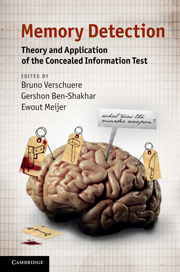Book contents
- Frontmatter
- Contents
- List of figures
- List of tables
- Notes on contributors
- Acknowledgments
- Part I Introduction
- Part II The laboratory: theoretical and empirical foundations of the Concealed Information Test
- Part III Field applications of concealed information detection: promises and perils
- Part IV Conclusions
- 16 Practical guidelines for developing a CIT
- Epilogue: current status and future developments in CIT research and practice
- Index
- References
16 - Practical guidelines for developing a CIT
Published online by Cambridge University Press: 05 June 2012
- Frontmatter
- Contents
- List of figures
- List of tables
- Notes on contributors
- Acknowledgments
- Part I Introduction
- Part II The laboratory: theoretical and empirical foundations of the Concealed Information Test
- Part III Field applications of concealed information detection: promises and perils
- Part IV Conclusions
- 16 Practical guidelines for developing a CIT
- Epilogue: current status and future developments in CIT research and practice
- Index
- References
Summary
Overview: In this chapter, we will formulate guidelines on how to develop a good CIT. These guidelines are based upon empirical data from CIT research as well as on theory on memory and orienting. We will outline how best to formulate questions and answer alternatives, how to conduct, score, and report the outcomes of the test. If these guidelines are followed, we are confident that the CIT can make an important contribution to police investigations.
The present book reviewed and summarized a large database of research on the Concealed Information Test (CIT), and a compelling case for its widespread adoption by law enforcement agencies was made (see Chapter 1). Clearly, designing adequate test questions is crucial for successful implementation and, as outlined in Chapter 8, good CIT questions need to fulfil two criteria. First, they need to refer to crime-relevant details that are present in the perpetrator's memory. Second, this information does not need to be known to an innocent suspect. The latter criterion primarily poses practical challenges to the police investigation process. Details of the crime should, for example, not be released through the media, nor be disclosed to a suspect in any interrogation preceding a CIT. The former criterion – what information is present in a suspect's memory – on the other hand, is not under the control of the investigative authorities. In this chapter, we will formulate guidelines on how to develop a good CIT, thereby maximizing detection efficiency and ensuring proper reporting.
- Type
- Chapter
- Information
- Memory DetectionTheory and Application of the Concealed Information Test, pp. 293 - 302Publisher: Cambridge University PressPrint publication year: 2011
References
- 5
- Cited by



